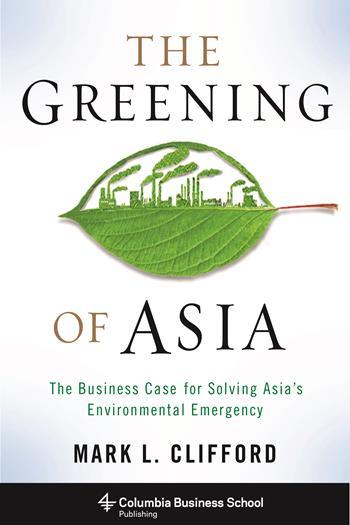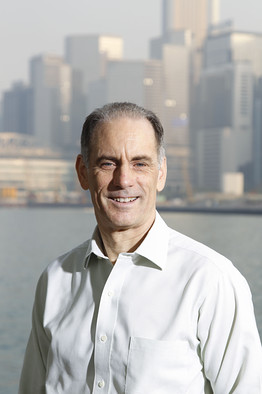In his new book The Greening of Asia, author Mark Clifford describes a region that is struggling with terrible pollution problems fueled by more than three decades of economic development at all costs. But he sees signs of hope: the business sector, he argues, is often taking the lead in finding ways to clean up the mess.
In The Greening of Asia, you argue that China is committed to cleaning up pollution, with good policies in place. So why is China still so polluted?
One of the major issues is the scale of China’s environmental problem. Just as it takes time to turn a massive container ship, it will take time before we see the full effects of China’s policies, no matter how aggressive.
The main culprit behind air China’s pollution crisis is coal, which accounted for about 64 percent of China’s electricity generation in 2014. China is home to one sixth of the world’s population, but it accounts for half of global coal consumption and 30% of global CO2 emissions.
China is the largest energy consumer, and it is also highly inefficient—it requires about three times as much energy to produce one dollar of GDP output as the U.S. If China cannot become more energy efficient and decouple growth from a rise in coal consumption than it will be impossible to keep global warming within the 2°C limit set by the Copenhagen Accord.
One reason China’s pollution crisis is hard to resolve is that coal consumers and end users of electricity in China do not pay the full cost of all the negative externalities associated with coal. Emissions from coal plants alone are responsible for a quarter of a million premature deaths per year. There is a real human cost to unrestrained coal consumption in China and coal consumers are not paying their way.
While the Chinese government has seen success by deploying massive amounts of capital and resources in a top down manner, China struggles with implementation at the ground level. There is often very little real enforcement of these top-down targets, and until China starts to view its pollution issue as an existential threat and we start to see officials losing their jobs due to poor environmental performance, it’s likely that China’s anti-pollution efforts will not succeed.
You also say that it’s several times cheaper to build an energy efficient building in China than to build a coal-fired power plant. So why doesn’t China have more energy efficient buildings?
 In China, most construction decisions made by developers are calculated based on the short-term cost of construction. The continuing costs of a building are not considered because developers don’t care if it costs more to heat and light and cool an inefficient building. Making matters worse is the short life span of buildings, which have large amounts of so-called embedded energy—the energy needed to make the steel, glass and concrete that is used in the building. The average lifespan of a Chinese building is as little as 20 years, according to Chinese researchers, or 35 years, says real estate consultancy Cushman & Wakefield, about one-third to one-half that in the U.S.
In China, most construction decisions made by developers are calculated based on the short-term cost of construction. The continuing costs of a building are not considered because developers don’t care if it costs more to heat and light and cool an inefficient building. Making matters worse is the short life span of buildings, which have large amounts of so-called embedded energy—the energy needed to make the steel, glass and concrete that is used in the building. The average lifespan of a Chinese building is as little as 20 years, according to Chinese researchers, or 35 years, says real estate consultancy Cushman & Wakefield, about one-third to one-half that in the U.S.
Higher construction costs for green buildings are the chief roadblock. Although there are government subsidies, developers say that they are not enough to cover the additional costs. According to Reuters, the maximum subsidy of 80 yuan per square meter is far short of the 300 yuan per square meter [about a 6 percent premium] that one developer says it costs it to get China’s maximum 3 star rating. Building codes are not rigorously enforced.
Builders and developers have every incentive to cut corners. Buyers—and society at large—pay the price of lax enforcement.
China has a Green Building Evaluation Label (GBEL) system, similar in intent to the U. S. Green Building Council’s LEED system. The GBEL system is administered by the government’s Ministry of Housing and Urban Rural Development. Unlike LEED, there is no professional accreditation system; in any event, there are not enough licensed professionals to ensure adequate accreditations.
You talk about business and government playing a role in cleaning up pollution in China. What role do you think civil society needs to—and can—play?
Civil society—NGOs and media—could will play a pivotal role in China’s cleanup by encouraging government and business to address environmental issues and ensuring transparency and accountability. All three stakeholders are important parts of the equation: government needs to set policy; business has the money, the technology, the people and the motivation to find solutions. Civil society is a check and balance in this promise.
The United States, Japan, and South Korea are among countries that have gone through a ‘get rich, get dirty, get clean’ process of environmental clean-up. Civil society played important roles in all of these countries—indeed, it is hard to think of a country that has cleaned up its environment without active engagement by civil society, even a top-down one like Singapore.
It takes time to build consensus. It was only in 1970, eight years after the publication of Rachel Carson’s Silent Spring, that the U.S. Environmental Protection Administration was established. In China, the viral spread of Chai Jing’s Under the Dome this past spring, with some 300 million Chinese downloads in the weeks that the documentary post remained easily available in the country, was an indication of public concern. Wary as China’s leaders remain of independent citizen action, it is hard to see how change can occur without involving ordinary people in a bottom-up, clean-up effort to re-fashion China from the world’s largest carbon emitter into a more environmentally benign country.



